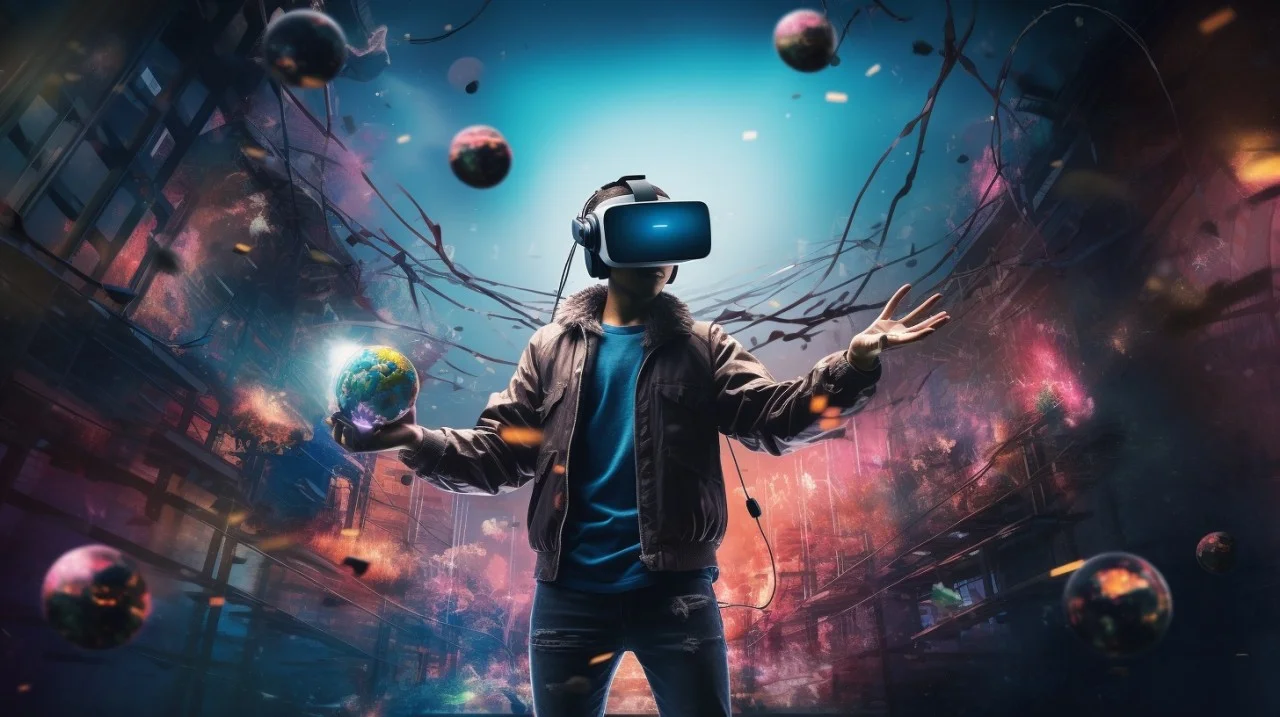Introduction to Virtual Reality (VR)
Vital Significance and Potential of Virtual Reality: Step into a world where imagination knows no bounds, where reality merges seamlessly with the virtual realm. Welcome to the extraordinary realm of Virtual Reality (VR), an enchanting technology that has captivated minds and ignited a spark of infinite possibilities. In this blog post, we delve into the vital significance and boundless potential of VR, exploring its evolution, advantages, applications across industries, and glimpses into its promising future. Brace yourself for an immersive journey as we unlock the doors to a universe where dreams come alive and boundaries cease to exist! So grab your headsets and let’s dive right in!
Table of Contents
The Evolution of VR Technology
Virtual Reality (VR) has come a long way since its inception. It all began with the idea of immersing oneself in a simulated environment, but the technology to achieve this was limited. Early attempts at creating virtual reality experiences involved clunky headsets and basic graphics.
However, as technology advanced, so did VR. The introduction of high-resolution displays and improved tracking systems revolutionized the immersive experience. The evolution continued with the development of motion controllers that allowed users to interact with their virtual surroundings.
Another significant milestone in VR technology was the advent of room-scale VR, which enabled users to move around physical spaces while remaining immersed in a virtual world. This breakthrough further enhanced the sense of presence and made VR more engaging than ever before.
In recent years, advancements in computing power have propelled VR even further. With powerful GPUs and processors becoming more accessible, developers can create visually stunning and realistic environments that transport users to new realms.
Moreover, there has also been progress in haptic feedback technology, enabling users to feel sensations within the virtual world. From vibrations simulating touch to full-body suits providing tactile feedback, these innovations bring an extra dimension of realism to VR experiences.
As we look ahead into the future, it is evident that VR will continue evolving at an exponential rate. The integration of artificial intelligence (AI) could potentially enhance user interactions by creating dynamic and adaptive virtual worlds tailored specifically for each individual’s preferences.
With ongoing research and development efforts focused on improving comfort levels through lighter weight headsets and wireless connectivity options; it won’t be long before we see even greater strides being made in making VR more accessible to everyone.
The evolution of VR technology holds infinite potential for various industries such as gaming, education, healthcare, architecture/design simulations – just to name a few! It opens up possibilities for training simulations where individuals can practice skills or scenarios without real-world consequences or risks involved.
Advantages of Using VR
Immersive experiences, unlimited possibilities. That’s what virtual reality (VR) brings to the table. With its advanced technology and incredible potential, VR offers a host of advantages that are revolutionizing various industries.
One of the main benefits of using VR is its ability to transport users to different places and environments without leaving their physical location. Whether it’s exploring ancient ruins or diving into the depths of the ocean, VR allows us to experience things we might never have the opportunity to do in real life.
Another advantage is the level of engagement and interactivity that VR provides. By putting on a headset, users can interact with virtual objects and characters in ways that were previously unimaginable. From playing immersive games to training for complex tasks, VR enables hands-on experiences like never before.
Moreover, VR has proven to be an effective tool for education and training purposes. Students can step inside historical events or scientific phenomena, enhancing their learning through visualizations and simulations. Likewise, professionals across various fields can practice scenarios in a safe environment before implementing them in real-life situations.
Furthermore, VR holds immense potential for therapy and healthcare applications. It has been used successfully in treating phobias by exposing patients gradually to their fears within a controlled virtual environment. Additionally, surgeons can rehearse complex procedures using realistic simulations before performing them on actual patients.
In conclusion…
The advantages offered by virtual reality are vast and ever-expanding as technology continues to evolve. From entertainment and education to healthcare and beyond – there seems to be no limit when it comes to unleashing the power of this immersive technology! So strap on your headset because th
Applications of VR in Different Industries
Virtual Reality (VR) technology has found its way into various industries, revolutionizing the way they operate and offering endless possibilities. In the field of healthcare, VR is being used for medical training and education, allowing students and professionals to practice complex procedures in a realistic virtual environment. This not only enhances their skills but also reduces the risk associated with real-life surgeries.
In the world of architecture and construction, VR enables architects to create immersive 3D models of buildings. This allows clients to visualize their future projects before they are built, making it easier for them to provide feedback and make informed decisions. Additionally, VR can also be utilized in the manufacturing industry for product design and prototyping purposes. Engineers can use VR simulations to test different designs without having to physically build multiple prototypes.
The entertainment industry has fully embraced VR as well. With virtual reality headsets becoming more accessible, gamers can now immerse themselves in lifelike gaming experiences like never before. Furthermore, filmmakers have started experimenting with VR technology to create immersive movies that transport viewers into different worlds.
Even the travel industry has hopped on board the VR train by providing virtual tours of popular destinations around the globe. Potential travelers can explore hotels, beaches, museums, or even take a stroll down bustling city streets – all from the comfort of their own homes.
These are just a few examples of how versatile Virtual Reality is when it comes to its applications across various industries. As technology continues to advance at an astonishing rate, we can expect even more innovative uses for this transformative technology in years to come.
The Future of VR
As virtual reality continues to advance at a rapid pace, the possibilities for its future are truly mind-boggling. One can only imagine what lies ahead as this cutting-edge technology continues to evolve and improve.
One potential area where VR could have a significant impact is in the field of entertainment. Imagine being able to step into your favorite movie or video game, fully immersing yourself in a digital world like never before. The experiences would be incredibly realistic and immersive, allowing you to interact with virtual characters and environments in ways that were previously unimaginable.
Another exciting prospect for the future of VR is its potential applications in education and training. Students could explore historical events firsthand, dissect complex scientific concepts through interactive simulations, or even practice medical procedures without any risk involved.
Furthermore, VR has the ability to revolutionize industries such as architecture and design by offering immersive experiences that allow clients to virtually tour buildings or visualize interior spaces before they are constructed.
In addition to these areas, there are countless other industries that stand to benefit from integrating virtual reality into their processes. From healthcare and therapy treatments to tourism and real estate, the possibilities seem endless.
While there are certainly still challenges and limitations that need addressing – such as cost barriers, motion sickness concerns, and technical constraints – it is clear that virtual reality holds immense promise for shaping our future.
In conclusion,
Virtual reality has come a long way since its inception and shows no signs of slowing down. Its infinite potential reaches far beyond just gaming; it has already started transforming industries across the board. With continued advancements in technology combined with widespread adoption, we can expect VR’s influence on society to grow exponentially in years to come. So buckle up – the future of VR is boundless!
Challenges and Limitations of Virtual Reality
While virtual reality (VR) has made remarkable strides in recent years, it is not without its challenges and limitations. One major hurdle is the high cost associated with VR technology. The equipment needed for a truly immersive experience can be quite expensive, making it inaccessible to many individuals and businesses.
Another challenge is the issue of motion sickness that some users experience when using VR headsets. This can limit the amount of time people are able to spend in virtual environments, as prolonged use may lead to discomfort or even nausea.
In addition, there are concerns about the potential negative effects on physical health. Extended periods of wearing a headset can cause strain on the eyes and neck muscles, leading to fatigue and discomfort.
Furthermore, creating realistic virtual environments requires immense computational power. This means that not all devices have the capability to run complex VR applications smoothly.
Privacy and security are also significant concerns in the world of VR. As more personal data is collected through these immersive experiences, ensuring user privacy becomes crucial.
Content creation for VR remains a challenge due to limited resources and expertise. It takes time and specialized skills to produce high-quality immersive content that engages users fully.
Despite these challenges and limitations facing virtual reality technology today, researchers continue to work towards solutions that will address these issues – paving the way for an even more advanced future for this exciting technology!
Conclusion: Vital Significance and Potential of Virtual Reality
Virtual reality (VR) has undoubtedly revolutionized the way we perceive and interact with the digital world. From its humble beginnings to the advanced technology it is today, VR has come a long way in a relatively short amount of time. Its vital significance and infinite potential cannot be overstated.
The evolution of VR technology has opened up endless possibilities across various industries. Whether it’s entertainment, healthcare, education, or even training simulations for professionals, VR offers immersive experiences that were once unimaginable. The advantages of using VR are numerous – from enhanced learning capabilities to improved productivity and efficiency.
In the entertainment industry, VR allows users to transport themselves into virtual worlds where they can fully experience movies or games like never before. Medical professionals are utilizing this technology for surgical training and patient therapy sessions, leading to better outcomes and reduced risks. Educational institutions are incorporating VR into their curriculums to provide students with hands-on learning experiences that go beyond textbooks.
As for the future of VR, there is no doubt that it will continue to evolve at an exponential rate. Advancements in hardware and software will make VR more accessible to a wider audience, allowing for greater adoption across different sectors. As technology progresses, we can expect improvements in graphics quality, motion tracking capabilities, and overall user experience.
However promising its potential may be, challenges and limitations still exist within the realm of virtual reality. High costs associated with developing and implementing cutting-edge systems remain a barrier for many businesses looking to adopt this technology on a large scale. In addition, issues such as motion sickness and limited content availability need further attention.
Despite these challenges though,don’t underestimate the power of virtual reality! The benefits it offers far outweigh any limitations currently faced by this rapidly advancing field.
While there is room for improvement,the future holds immense promise.
Virtual reality opens up new frontiers,constantly pushing boundaries,and unlocking opportunities that were once out-of-reach.
Its impact on society will only grow as we continue to explore its infinite potential.
Virtual reality has become







